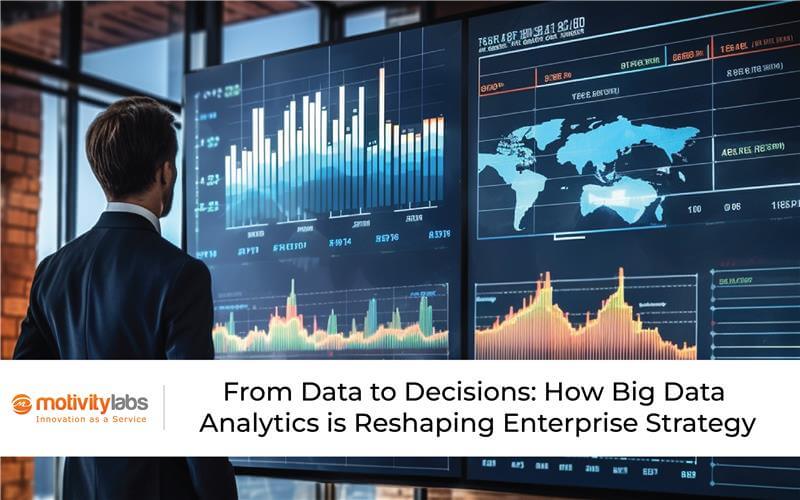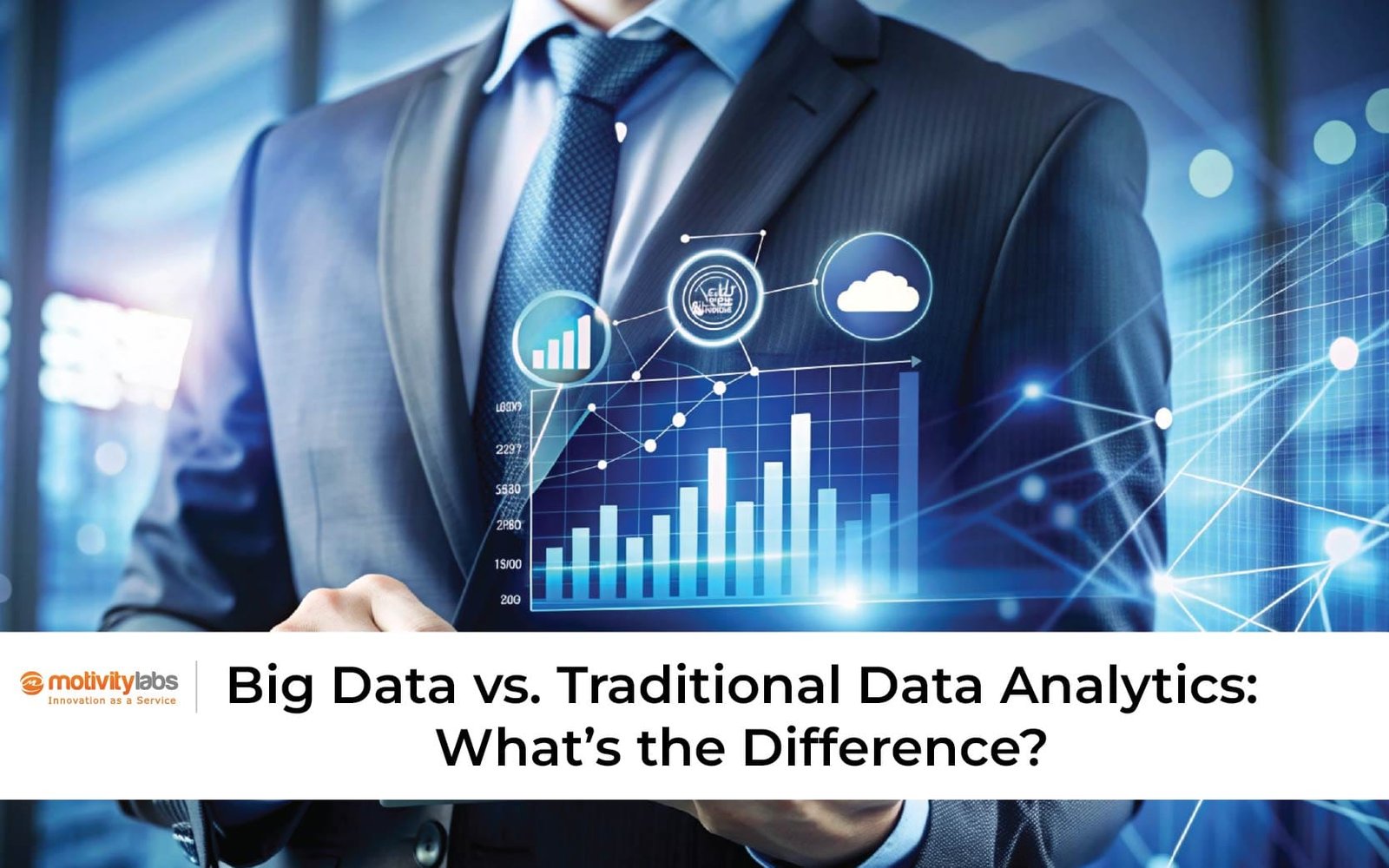Picture this: your executive team is about to greenlight a multi-million-dollar product line. Market projections are discussed, trends debated, and consumer behavior dissected, but no one’s truly sure if the insights are grounded in reality. The data exists, but it’s fragmented across spreadsheets, legacy systems, and outdated dashboards.
This isn’t rare. Even large enterprises continue to treat data as a by product rather than a strategic asset. As a result, decisions become reactive, intuition-led, and delayed. The gap between raw data and real decisions widens-leading to missed opportunities, inefficiencies, and misaligned priorities.
Now imagine the opposite: a decision framework where insights are instant, contextual, and predictive-where your next strategic move is guided not by gut, but by evidence. This is what Big Data Analytics delivers: a paradigm shift that turns information into a competitive weapon and organizations into intelligent, adaptive ecosystems.
The Evolution: From Descriptive to Prescriptive
Descriptive → Diagnostic → Predictive → Prescriptive
Traditional analytics has long answered ‘what happened?’ and ‘why did it happen?’—descriptive and diagnostic. But today, Big Data Analytics extends that question to ‘what will happen?’ and ‘what should we do about it?’
- Descriptive analytics tracks performance metrics—sales trends, costs, and churn.
- Diagnostic analytics identifies causes behind those metrics.
- Predictive analytics uses machine learning and historical data to forecast what’s likely next.
- Prescriptive analytics recommends optimal actions based on those predictions.
The organizations mastering predictive and prescriptive analytics gain foresight, not just hindsight. They see patterns emerging in real time and act preemptively—turning volatility into opportunity.
Why Big Data Analytics Matters for Enterprise Strategy
1. Uncovering Hidden Patterns and Signals
Modern enterprises are flooded with data from sensors, transactions, social channels, and digital touchpoints. Hidden within are subtle signals—emerging market trends, process inefficiencies, or customer churn precursors. Big Data Analytics helps surface these insights early, allowing strategy to be informed by facts, not guesses.
2. Accelerating Insight to Action
Speed defines survival. Insights that arrive late are useless. Through scalable cloud processing, automation, and real-time analytics, organizations can shrink decision latency. Alerts, algorithmic triggers, and adaptive dashboards translate complexity into actionable intelligence—turning analysis into execution within hours, not weeks.
3. Democratizing Decisioning
When analytics is embedded across departments—from marketing and finance to operations—it empowers every function to make informed calls. Big Data Analytics decentralizes intelligence, ensuring decisions are data-backed across all levels, not confined to data science teams.
4. Enabling Adaptive Strategy
Static three-year strategies crumble in fast-moving markets. Adaptive enterprises operate through iterative, data-fed loops—testing, learning, and pivoting in real time. Big Data Analytics enables this continuous adaptation, helping organizations stay responsive to change rather than overwhelmed by it.
5. Creating Competitive Advantage
Organizations with data-anchored strategies outperform peers. A BARC survey found that 69 % of companies cite better strategic decision-making as a top benefit of Big Data Analytics, 54 % improved operational control, 52 % better customer understanding, and 47 % cost reductions.
Similarly, it’s estimated that 58 % of companies leveraging data-based decision-making outperform their revenue targets. These aren’t vanity metrics—they underscore how analytics is becoming the backbone of profitability and performance.
Key Pillars for Success with Big Data Analytics
1. Robust Data Infrastructure & Governance
A strong foundation demands scalable, interoperable systems that integrate data across CRMs, ERPs, IoT, and external sources. But quantity without quality is chaos. Governance, lineage, and privacy must anchor every data initiative. Without trust in data, analytics adoption falters.
2. Analytics Talent & Culture
Algorithms don’t create value—people do. Successful enterprises foster multidisciplinary teams that blend domain expertise with data science. Culturally, curiosity and experimentation must be rewarded; skepticism toward assumptions should be the norm.
3. Advanced Platforms & Tooling
Today’s analytics ecosystems thrive on cloud-native architectures, distributed compute (e.g., Apache Spark), real-time engines (Kafka, Flink), and AI-assisted modelling. Yet equally vital are visualization tools, automated pipelines, and model-monitoring frameworks that connect insight to workflow.
4. Integration into Business Processes
Analytics must be part of decision-making rituals—weekly reviews, product planning, resource allocation. If insights live in silos, they die unused. Embedding analytics into business cadence ensures continuity between data and decision.
5. Continuous Feedback & Evolution
No model is static. Business environments shift, customer behaviors evolve, and algorithms drift. Continuous validation and retraining of models—plus feedback loops across departments—keep analytics relevant and trustworthy.
Real-World Illustrations: Big Data Analytics in Action
Retail & Inventory Optimization
A global retailer merged point-of-sale data, supplier feeds, weather forecasts, and social sentiment into a unified analytics engine. The result? 30 % fewer stockouts and leaner inventory cycles—boosting customer satisfaction while cutting costs.
Financial Services & Fraud Detection
In banking, Big Data Analytics integrates transaction histories, behavioral biometrics, and device fingerprints to detect anomalies. Suspicious patterns trigger instant alerts, helping banks prevent fraud before it occurs—saving millions annually.
Manufacturing & Predictive Maintenance
IoT sensors stream operational data from machinery. Analytics models detect early signs of equipment failure, allowing maintenance before breakdowns. This shift from reactive to predictive maintenance reduces downtime and maximizes asset life.
Marketing & Hyper-Personalization
By analyzing browsing patterns, CRM data, and engagement behavior, brands can now tailor messaging to individual customers in real time. The result: higher conversion rates, better customer loyalty, and measurable ROI.
Challenges (and How to Overcome Them)
1. Talent & Skill Shortage: Analytics requires cross-disciplinary talent. Upskilling programs, academic partnerships, and collaboration with specialized consultancies can help close the talent gap.
2. Data Silos & Legacy Infrastructure: systems create data isolation. Migrating to unified data platforms or virtualized data lakes enables cross-functional analytics and holistic insights.
3. Resistance to Change: Cultural resistance remains the hardest barrier. Overcome it with transparent, explainable models and “human-in-the-loop” frameworks that enhance trust and accountability.
4. Scalability & Cost: Analytics workloads can balloon rapidly. Cloud elasticity, modular architecture, and cost-aware data storage strategies help sustain performance without overrunning budgets.
5. Ethics, Privacy & Bias: Data misuse or model bias can damage reputations. Instituting governance frameworks, anonymization protocols, and bias detection audits ensures compliance and fairness.
A Practical Playbook: From Prototype to Transformation
- Identify a high-impact use case — Start small but strategic (e.g., churn prediction or demand forecasting).
- Build an MVP and test it — Measure outcomes, refine hypotheses, and validate results.
- Show measurable wins — Demonstrate ROI through early successes and expand buy-in.
- Scale and standardize — Move from isolated projects to platform-driven analytics.
- Integrate across strategy — Connect analytics to planning, resource allocation, and innovation.
- Institutionalize learning — Embed analytics into governance structures and continuous improvement cycles.
The Big Question: Is Big Data Analytics Optional Anymore?
In a hyper-volatile market, relying on intuition and outdated reports is like sailing without a compass. Enterprises that operationalize Big Data Analytics are the ones turning uncertainty into advantage. They predict demand, preempt risk, and personalize at scale. Those that delay remain reactive—forever catching up.
But analytics transformation isn’t plug and play. It demands patience, leadership sponsorship, and cross-functional orchestration. Many organizations start strong but stall in ‘pilot purgatory.’ The differentiator lies in execution—translating insight into enterprise-wide decision capability.
Why Motivity Makes the Difference (and How You Can Get Started Today)
That’s where Motivity comes in. Motivity bridges the gap between insight and action—helping organizations operationalize analytics faster, smarter, and more securely.
Unlike generic analytics tools, Motivity is designed for real-world enterprise agility:
- Modular, full-stack architecture that integrates ingestion, modelling, and execution seamlessly.
- Prebuilt analytic accelerators for rapid deployment of high-impact use cases like churn prediction or inventory routing.
- Low-code decision integration allowing business teams—not just data scientists—to embed analytics into workflows effortlessly.
- Built-in governance with explainability, role-based access, and bias monitoring to ensure trust and compliance.
With Motivity, enterprises skip the learning curve of custom builds and move directly into measurable results. Its ecosystem doesn’t just visualize insight—it operationalizes it, ensuring that every strategic move is informed by real-time intelligence.
If your enterprise is ready to evolve from reaction to foresight, from scattered reports to unified decision intelligence, Motivity is your transformation engine.
Schedule a demo or strategy consultation today—because in tomorrow’s business landscape, leadership won’t be about intuition. It will be about insight.



